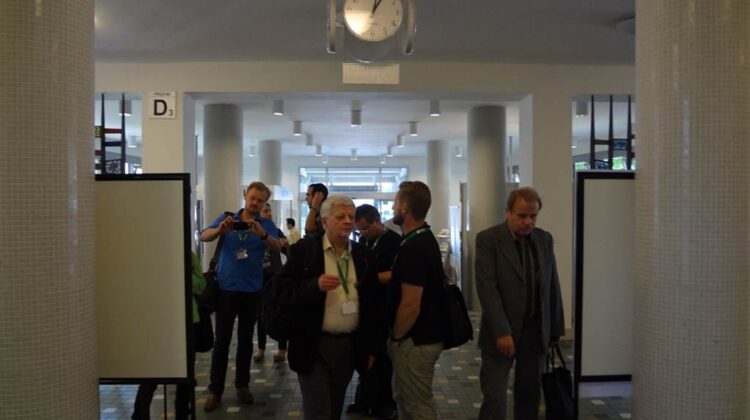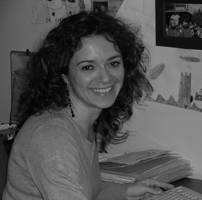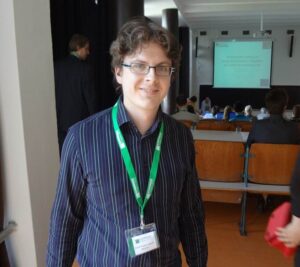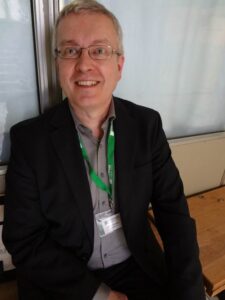
Euronoise circulation space
On Monday afternoon, Arianna Astolfi and Monika Rychtarikova chaired an extensive session on educational buildings. Most sessions where about classrooms but there was also a focus on early years and day care environments.
The sessions included:
Relationship between Vocal Doses and Voice Disorders on Primary School Teachers. (Arianna Astolfi, Pasquale Bottalico, Anna Accornero, Massimiliano Garzaro, Juri Nadalin, Carlo Giordano)
Some facinating and detailed information in this study, which was based on a survey of 29 No. teachers. A detailed look at measuring parameters to quantify voice fatigue due to vocal load, as voice fatigue is accociated with a high rate of voice disorders which is often perceived as a burning sensation for the teacher.
Arianna Astolfi, Politecnico di Torino, Italy

Classroom Acoustics Design Guidelines based on the Optimisation of Speaker conditions. (David Pelegrin-Garcia, Jonas Brunskog)
David stressed the need for classrooms to provide good clarity of speech, control noise and late reflections and support the voice of the teacher to provide a sensation of vocal comfort. Voice support must balance the direct sound versus late sound reflections and also there must be consideration for flexible teaching methods (not just one person speaking). David also mentioned that a volume of 6m3/student was desirable.

David Pelegrin Garcia – KU, Leuven, Belgium
Rank Ordering of Class Grades and Noise Interference by Means of Listening Efficiency in Primary Schools.Nicola Prodi, Chiara Visentin, Alice Feletti
This paper was a development of “noise interference- by means of listening efficiency” presented by Prodi 2010 and explored the psychophysical measure of the effort put into the cognitive process. It looked at teachers voice loads and highlighted that while traffic noise and tapping noises in a class are disturbing, it is activity noise (inc. babble) which is clearly the most disturbing for the students.
Fatigue and Adaptation in Noisy Primary Schools.Acoustics and Noise Management in New Zealand Early Education Environments.
Stuart J.McLaren, Wyatt Page, Philip Dickinson, Sarugunam Sivaraj
Children used lightweight dose badges to moniter sound levels. LAeq for 6-8hours was 65-79dB evenly spread and in all 3 measured day centres. In many cases sound levels peaked at unacceptably high levels. Autistic, gifted and speech therapy children were most badly effected.
Stuart stressed the importance of acoustics but also noise management – engage managed activity situations instead of policing every situation with noise meters.
Noise Control in After-School Centres – Methods and Results.Per Moberg Neilsen, Inger-Marie Wiegman, Jesper Kristiansen, Soren Peter Lund, Roger Persson
Per highlighted that noise was the single most contrubuting factor in the high levels of sick leave experience by teachers in the study. Key guidance is to; focus on space layout and noise reduction furniture (as a psychological not physical function – small cozy spaces) then reduce noise propagation. Per also showed a creative approach regarding control over large space zoning with “sound absorbing tunnels”. For more information about this study and the sound absorbing tunnels click here
On the Use of “Green Materials” for the Acoustic Correction of Classrooms.Gino Iannce, Luigi Maffei, Patrizia Trematerra
A look a natural, renewable materials potential to be alternative absorbers to existing mass produced absorbers.
Simple Formulas for Estimation of Room Acoustic Parameters.Erling Nilsson
Erling discussed the significan differences in sound strength “G” and speech clarity “C50” / D50 are obtained even though the reverberation time remains unchanged. Reverbaration alone does not describe the differences in the way we often perceive rooms paricularly when we consider occupied sound levels. The calculation of “G” and C50 is based on estimated reverberation time for diffuse conditions as shown in his equations meaning this reverberation time will probably represent the early arriving sound energy better than the late part. The later part is more related to the non-difuse reverberation as explained in his equations.

Erling Nilsson, Ecophon
Subjective Indices Related to Speech Transmission in Classrooms – an Appraisal (Arianna Astolfi, Pasquale Bottalico, Gianfranco Genta, Giulio Barbato, Raffaello Levi)
Again interesting details being studied in Italy.

